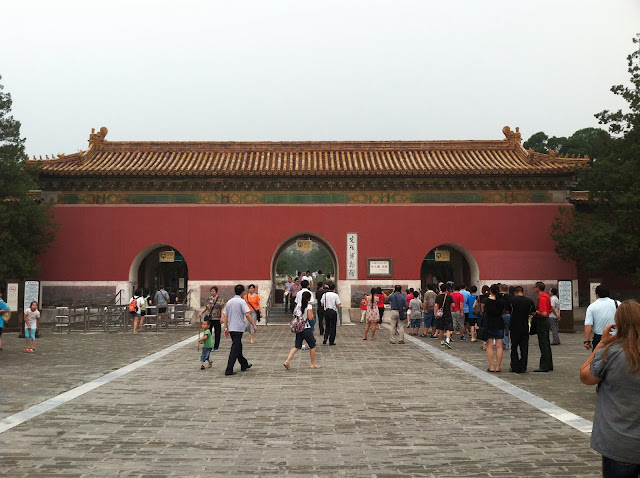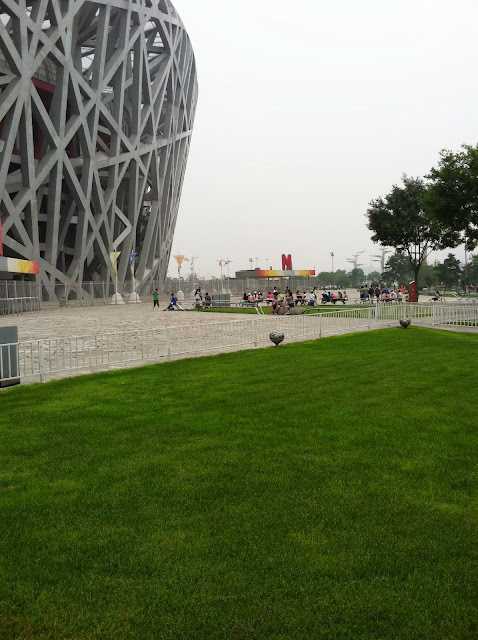Like most Americans, I have heard about China since I was a child. I have read the sayings of Confucius and seen pictures of China's (then) antiquated agriculture. Like many other children, I fully intended to dig a hole deep enough to get to China, and my parents told me to clean up all the food on my plate at meals because children were starving in China (that was a common cultural saying then; don't try to figure out the logic!).
Turfgrass and China
From a historical context, China is a case study on the detrimental effects of removing all turfgrass from urban centers. The following is an excerpt from a textbook of the late Dr. James Beard, considered to be the father of modern turfgrass science:
"During the Cultural Revolution of the late 1960s and early 1970s in China, the grassed lawns, trees, and shrubs were removed in major urban areas because they were viewed negatively by the government officials as symbols of a capitalistic society. As a consequence, the dust problem became so severe that at times car traffic on roads had to be closed because of a lack of visibility for safe travel. Eventually, the rate of human diseases associated with the aerial dust pollution in these Chinese cities was much greater than for comparable cities in other parts of the world. Initially, government officials attempted to solve the problem by employing large groups of workers to regularly sweep up the dust from barren ground. The program was unsuccessful. This author was then contacted by the Chinese Botanical Society about revegetation strategies. The officials decided to reintroduce trees, but the problem was not significantly lessened until after an official policy of reintroducing turfgrasses onto the bare areas was implemented. It should be noted that windborne dust from rural areas remains a problem." (2)
So it was significant that China hosted the 12th International Turfgrass
Society Conference, of which I had the privilege of attending. Below
are a few pics of the conference and some turfgrass around Beijing.
Other Highlights from around the City:
China and Cuisine:
Graduate students from China who have been or are in the turfgrass program at K-State:
Since then I've been blessed to know several wonderful people from China, including some who are my peers now or were my peers while I was in graduate school. Also, I've served as major adviser to two Chinese graduate students (one currently) and have served on the advisory committees of a number of other Chinese graduate students. Some of my peers and graduate students (former and current) are pictured below. What a privilege it has been to work with them!
In 2013, I was fortunate to visit China to attend the 12th International Turfgrass Society Conference (this post is long overdue)! Really I only visited Beijing and surroundings, and I'm aware there is much more to China. But what I saw was impressive.
China is a beautiful gem in God's creation, including its people, culture, and landscape. I hope you enjoy a few pictures of my visit there. (1)
In 2013, I was fortunate to visit China to attend the 12th International Turfgrass Society Conference (this post is long overdue)! Really I only visited Beijing and surroundings, and I'm aware there is much more to China. But what I saw was impressive.
China is a beautiful gem in God's creation, including its people, culture, and landscape. I hope you enjoy a few pictures of my visit there. (1)
 |
| The entrance to Ming Tombs, 30 miles NW of Beijing. It is a vast burial site of 13 of the 16 Ming-dynasty (1368-1644) emperors. The tombs are spread over 15 square miles. |
 |
| Bringing
Kansas State University (KSU) to China! Dr. Jack Fry, his wife
Nathalie, and me (right to left). This was at the Summer Palace. |
Turfgrass and China
From a historical context, China is a case study on the detrimental effects of removing all turfgrass from urban centers. The following is an excerpt from a textbook of the late Dr. James Beard, considered to be the father of modern turfgrass science:
"During the Cultural Revolution of the late 1960s and early 1970s in China, the grassed lawns, trees, and shrubs were removed in major urban areas because they were viewed negatively by the government officials as symbols of a capitalistic society. As a consequence, the dust problem became so severe that at times car traffic on roads had to be closed because of a lack of visibility for safe travel. Eventually, the rate of human diseases associated with the aerial dust pollution in these Chinese cities was much greater than for comparable cities in other parts of the world. Initially, government officials attempted to solve the problem by employing large groups of workers to regularly sweep up the dust from barren ground. The program was unsuccessful. This author was then contacted by the Chinese Botanical Society about revegetation strategies. The officials decided to reintroduce trees, but the problem was not significantly lessened until after an official policy of reintroducing turfgrasses onto the bare areas was implemented. It should be noted that windborne dust from rural areas remains a problem." (2)
 |
| Opening session of the 12th International Turfgrass Society Conference, 2013. The conference lasted 6 days, from July 14-19. |
 | ||||||
| Presenting my scientific research at the conference. |
 |
| Natural turfgrass at the site of the 2008 Summer Olympics in Beijing. Here near the Bird's Nest Stadium. |
 |
| A Chinese appeal to your conscience to keep off the turfgrass. I
wonder if this sign would work in America! This was at the 2008 Summer Olympics Grounds. |
 |
| Turfgrass inside the Forbidden City. Unfortunately it was artificial, not natural turfgrass! |
Other Highlights from around the City:
 |
| This rickshaw driver at Qian Hai Lake in the Hou Hai neighborhood, north of the Forbidden City, was giving Dr. Yaling Qian (turfgrass scientist from Colorado State Univ.) a hard sell for a ride around the area. Hou Hai consists of 3 lakes surrounded by an expansive and labyrinthine sprawl of age-old alleys; it was most interesting. Yaling generously gave Dr. Jack Fry, Nathalie his wife, and me a tour around the Hou Hai neighborhood and the Summer Palace. Yaling and I were graduate students at the same time back in the 1990s at Kansas State University; Jack Fry served as her major adviser. |
 |
| The sky was clear on only one of the 7 days I was in Beijing. I was surprised to see mountains around the city! This was the view from the window of my room in the Beijing Yulong Hotel. |
 |
| An interesting shirt for sale at a street vendor near the Forbidden City. Looks suspiciously like our (then) President Obama in a Chinese Communist Military Uniform. |
China and Cuisine:
 |
| Dr.
Jinman Fu (right) very graciously treated us to a great dinner in a private room in the restaurant. Dr. Fu was a graduate student at Kansas State University, advised by Dr. Fry. I had the privilege of serving on his committee. Also pictured (right to left) are Dr Yiewui Jiang (Purdue Univ.), who was formerly a graduate student at Kansas State Univ., Dr. Bingru Huang (Rutgers Univ.), my predecessor (of my current position at Kansas State Univ.), Nathalie and Jack Fry, me, and Dr. Yaling Qian (Colorado State Univ.). |
 |
| The squirrel fish was most interesting, and very tasty! |
 |
| Dr. Kemin Su graciously treated Dr. Fry, Nathalie, and I to an amazing Chinese dinner in a private room in a nice restaurant. Here the chef was serving Peking Duck. |
Scorpions for dinner anyone? This was at a street vendor in Beijing on a bustling Friday evening. (YouTube: https://youtu.be/P-KXB8-yht4)
 |
| Street
vendors were everywhere in Beijing! Most things looked tasty. I wasn't
sure what to think about the stinky tofu though...mostly because of the bad smell. |
 |
| McDonald's is everywhere, here somewhere in Beijing! |
Graduate students from China who have been or are in the turfgrass program at K-State:
 |
| Kemin Su, my first graduate student, at the Birdsnest Stadium in Beijing. He is from Shanxian (County), Shandong Province. He now resides in Kalamazoo, Michigan. |
 |
| Mu Hong is currently my graduate (doctoral) student; I serve as his major adviser. He is from Shantou, in the Guangdong province. |
 |
| Mingying Xiang is from Weihai, in the Shandong province. I served on her graduate committee. She is now at Univ. of California, Riverside. |
 |
| Qi (Chee) Zhang, Associate Professor North Dakota State University I served on Qi's graduate committee. |
Footnotes
(1) Some information about tourist sites was obtained from: Top 10 Beijing, DK Eyewitness Travel, 2011.
(2) Beard, J.B. 2008. Integrated multiple factor considerations in low-precipitation landscape approaches. p. 33-40 In J.B. Beard and M.P. Kenna (editors) Water quality and quantity issues for turfgrasses and urban landscapes. Council for Agricultural Science and Technology, special publication 27.








